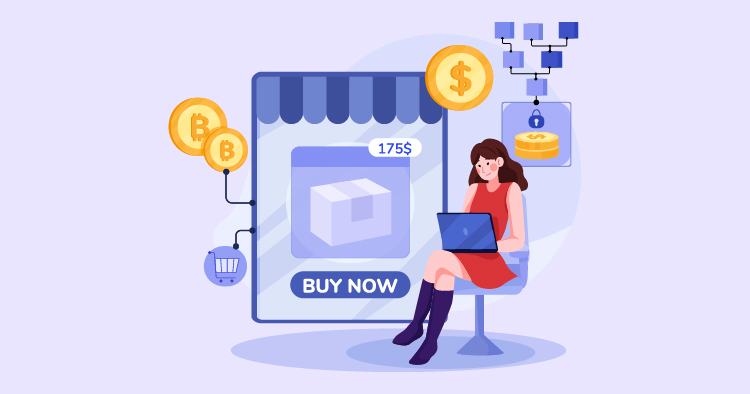Growing an online store involves more than just having great products; it’s about ensuring people notice your brand among countless others. As more people shop online, your e-commerce business needs to catch their eye and convince them to buy from you. This means getting creative with how you market yourself and ensuring that once potential customers find you, they enjoy the experience enough to purchase—and then do it all over again. We’ll walk through some key strategies to help you attract new shoppers and turn them into loyal fans.
Attracting new customers to your ecommerce store is crucial for your business to thrive and expand. With so many competitors trying to catch shoppers’ attention, you must differentiate your store to appeal to potential customers. There’s no one-size-fits-all solution, so it’s essential to try different strategies to see which resonates with your audience. Combining traditional marketing with digital strategy is often the key to attracting new customers.
If you’re looking for effective ways to increase traffic and sales for your ecommerce business, the following ten tactics can help you achieve that.
Personalize Your Ecommerce Homepage
Making your customers feel valued can go a long way. By personalizing your homepage to reflect a user’s browsing habits or preferences, you create a tailor-made shopping experience. For instance, if visitors have looked at pet supplies before, showing them pet-related products on their next visit might encourage them to purchase them.
To personalize effectively, you can gather user data through methods like cookies or during account sign-ups. It is essential to let customers know how you’re using their data to maintain their trust. Advanced technologies like AI and machine learning can take personalization to the next level by analyzing user behavior and providing intelligent product recommendations that may lead to a sale. Remember, the more relevant the user experience, the more likely customers will return and buy.
Increase Your Ecommerce Site’s Search Visibility
To attract more customers, it’s crucial that people can find your online store easily through search engines like Google. Search engine optimization, or SEO, is your tool for climbing the ranks in search results. Here’s how you can work on it:
Start by sprinkling relevant keywords across your website. These are the terms that potential customers use when searching for products like yours. Pay special attention to product titles and descriptions, as these are prime spots for keywords.
Don’t overlook your meta descriptions and the alt text for images. These elements help search engines understand what your pages are about, which can boost your visibility.
Struggling with Digital marketing? Book Your Free Strategy Session!
- 30-Minutes Session
- Expert Insights
- Data-Driven approach
- Optimized Strategies for Your Goals
Select one of over 500 designs and establish your online presence.
- Free Web Hosting
- Fully Managed Solutions
- Scalable Websites
- No Hidden Cost
Building high-quality backlinks is another powerful SEO strategy. When reputable sites link to your store, it signals to search engines that your site is trustworthy and authoritative.
Lastly, make sure your website is mobile-friendly. More and more people shop on their phones, and search engines favor sites that cater to these users.
Use High-Quality Images and Product Descriptions
Customers who browse your online store can’t touch or try your products, so excellent visuals are key. Use high-resolution images that show your products clearly from various angles. Good lighting and professional presentation can make all the difference.
But a picture isn’t enough on its own. Your product descriptions should be engaging and informative. They need to clearly explain what the product does and its benefits and answer common questions. Keep it straightforward and easy to read.
Adding videos to your product pages can be a game-changer. They allow customers to see the product in action, which can help them decide if it’s right for them.
Remember product reviews. They’re precious to shoppers looking for confirmation that your product is as good as you say it is. Positive reviews from past customers can significantly boost confidence in your products.
Use Email Lists Wisely
Email marketing is a powerful way to connect with potential customers, but it’s important not to overwhelm them. When using your email list, send relevant messages that offer value. For instance, a warm welcome email to new subscribers with a discount or free shipping can encourage them to make their first purchase.
Timing can also significantly affect the effectiveness of your emails. Sending out information about a holiday sale or announcing a new product at the right moment can lead to quick customer engagement. Personalization goes a long way, too. Tailor your emails with personalized product recommendations or special deals based on the customer’s past behavior to make them feel special.
Run Effective Ecommerce Sales Promotions
Sales promotions are a great way to draw in new customers. By offering time-sensitive deals like discounts or buy-one-get-one offers, you create urgency and encourage people to buy now rather than later. These promotions don’t have to be costly; even small incentives can be enticing if they provide added value.
Select one of over 500 designs and establish your online presence.
- Free Web Hosting
- Fully Managed Solutions
- Scalable Websites
- No Hidden Cost
Make sure that any promotions are easy to find on your website. Transparent banners, attention-grabbing pop-ups, or a special section for deals can make all the difference. And don’t just rely on your website; use other channels like social media and email to get the word out. The more people know about your promotions, the more likely they will check them out and potentially become new customers.
PPC Advertising to Boost Your Ecommerce Site’s Traffic
Pay-per-click (PPC) advertising is a strategic tool that can lead many interested buyers to your online store. When people search for products online, PPC ads can appear right at the top of their search results, where they’re easy to see and click on.
Platforms such as Google Ads are helpful because they let you choose exactly who sees your ads. You can target potential customers based on where they live, their age, their interests, and other details. This helps make sure that your ads show up for the right people.
But keep an eye on your spending with PPC. The costs can increase, especially if many other businesses want to advertise your keywords. It’s essential to check on your ad campaigns regularly to ensure they’re not costing more than they’re worth.
You can use different PPC ads, such as ones that showcase your products in a shopping format or others that appear on websites as display ads. Try different types to see which ones help your online store the most.
Take Advantage of Social Media
Social media is more than just a place to chat with friends—it’s a powerful tool for getting your products seen by more people. Sites like Instagram and Facebook are great for posting eye-catching images and videos of what you’re selling.
For example, Facebook has tools that let you show your ads to a particular group of people. This means you can ensure your products are seen by those most likely want them. If someone has been to your website but didn’t buy anything, you can use social media ads to remind them about what they’re missing out on.
The recommendations of happy customers can be compelling. Encourage your customers to post about their positive experiences and to mention your brand when they do. This kind of social proof can be very persuasive to potential buyers.
Struggling with Digital marketing? Book Your Free Strategy Session!
- 30-Minutes Session
- Expert Insights
- Data-Driven approach
- Optimized Strategies for Your Goals
Also, think about using fun, interactive content like polls or quizzes on social media. These can get people talking about your brand and interested in your offer.
User-Generated Content
User-generated content (UGC) is like a vote of confidence from your customers. When new shoppers see reviews, photos, or testimonials from others who have bought your products, it can make your brand seem more trustworthy. Think of it as a friend recommending a good restaurant—it makes you more likely to try it out.
To get this kind of content, you can encourage your customers to post about their purchases on social media. Creating a unique hashtag for your brand makes it easy to find all the posts about your store in one place. Plus, it’s a fun way for customers to engage with your brand and each other.
Some creative brands even run contests where customers can show how they use their products. The winner might get their picture featured on the brand’s social media or even receive a free item. It’s a win-win situation: the customer receives a prize, and the brand gets excellent content.
But remember, asking for permission before using anyone’s content for your marketing is essential. This shows that you respect their work and can lead to even better customer interactions.
Create a Blog
Having a blog is like having a conversation with your customers. It’s not just about selling products—it’s about sharing knowledge, news, and tips to help your customers. This can make your brand stand out as a knowledgeable leader in your field.
Blogs are also great for search engines. Search engines take notice when you write about topics that interest your audience, and do it regularly. This can help more people find your store when they’re searching online.
But don’t forget to guide your readers to the next step. A call to action (CTA) is like a signpost at the end of your blog post. It can lead readers to check out a new product, sign up for your newsletter, or learn more about your brand. A good CTA can turn a reader into a customer.
The key is to keep your blog informative and exciting, not just a sales pitch. When people find value in your writing, they are more likely to return—and maybe even make a purchase.
Encouraging Customers to Buy More
Offering rewards for shopping with you, like loyalty programs or bonuses for referring friends, can encourage customers to buy more and even attract new customers. For instance, a system where customers earn points for each purchase can encourage them to return and shop again.
If someone is new to your website, giving them a discount code can turn them from a visitor into a buyer. It’s a good idea to make this discount easy to find and use on your site.
Free shipping can also make a big difference. Many people decide not to buy something because the shipping cost is too high. By offering free shipping, you can keep more people from leaving their carts full and walking away.
Sometimes, a sale that lasts only a short time can make people buy on impulse. They feel like they have to act fast to get a good deal, which can increase sales.
Making Your Online Store Easy to Use
How your website works and looks can affect whether someone buys something. You want to ensure it’s easy to navigate, the pages load quickly, and checking out is simple. This will create an excellent experience for your visitors.
Nowadays, many people shop using their phones, so your website needs to work well on mobile devices. It’s not just a nice extra—it’s essential.
You can use A/B testing to see what your customers like best. This means trying out different colors for buttons or other places for ads to see what gets the best response.
Having a section for frequently asked questions or a chat service available right away can also help customers when needed. This can improve their experience and might even lead to buying something immediately.
Understanding Your Customers Through Data
Getting to know your customers better is a smart move. By examining your data, you can learn a lot about what they like and don’t. Consider how they shop and what they buy. This knowledge will help you improve your marketing even more.
If you ask your customers what they think through surveys or feedback forms, they can tell you how to improve your products or services and help you improve how they experience your website or store.
Keep an eye on essential numbers like how many people buy something, how many leave your site quickly, and how much money customers spend over time. These numbers show what’s working well and what you could do better.
You should also pay attention to when and what people buy. Maybe you notice you sell more of something during the holidays or that specific deals work well. Use this information to plan what to do next.
Becoming a Recognized Expert in Your Field
When you become known for your knowledge, more people start paying attention to you. This means you do more than sell things. You also share helpful tips, teach through webinars, or talk at events about your industry.
Get involved in online discussions about your area of business. When you give good advice and show what you know without expecting anything in return, people start to see you as an expert.
Working with influencers or other experts can help you reach even more people. You could do a webinar together, start a podcast, or make content that interests both of your fans.
To be seen as an expert, it would be best to keep up the excellent work. Update your blog regularly, post on social media, and give your audience exciting things to read or watch. This will keep them returning and help you find new customers, too.
Final Thoughts
Success in e-commerce doesn’t stop at getting people to your site; it’s about making them want to stay and buy, then return for more. This requires a blend of intelligent search engine optimization (SEO), marketing that feels personal, and top-notch customer service. It’s also essential to keep your finger on the pulse of what’s new and what your customers want so you can tweak your approach and stay ahead of the game. The endgame creates a cycle where new customers become repeat ones, helping your e-commerce business flourish over time.



